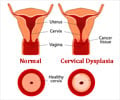A new study has estimated the costs of providing comprehensive screening and diagnostic services to under-or uninsured, low-income women to identify those with breast or cervical cancer for treatment. The median cost of screening a woman for breast cancer was $94, and the cost per breast cancer detected was $10,566. For cervical cancer, these costs were $56 and $13,340, respectively. The study is published in the February 1, 2008 issue of CANCER, a peer-reviewed journal of the American Cancer Society.
Many deaths from breast and cervical cancer would be avoidable through the use of mammography and Pap tests, respectively. In 1990 Congress established the National Breast and Cervical Cancer Early Detection Program (NBCCEDP)—which is now the largest cancer screening program in the United States—to provide support and assistance to increase breast and cervical cancer screening among medically under-served, low-income women. Program services are available in all 50 states, the District of Columbia (DC), 4 U.S. territories, and 13 American Indian/Alaskan Native organizations. To help determine the level of funding required to reach and screen eligible women, Ekwueme and colleagues set out to estimate the costs per woman served, per woman screened and per cancer detected through this program.The investigators collected data from July 2003 through June 2004 from nine of the 68 NBCCEDP programs operating in the United States. They found that when non-federal contributions are included, the median cost of all screening services combined was $555 per woman. Screening tests accounted for the highest cost, $221 per woman served, and public education/outreach incurred the second highest cost, $63.
The analysis revealed that 58.2 percent of the program’s resources were allocated to clinical services, including screening and diagnostic follow-up, referral for treatment, and case management. The remainder of NBCCEDP’s funds were used to support non-screening activities such as data management, public education/outreach, professional education and quality assurance and improvement.
The authors note that the study “provides the first systematic cost analysis in the selected [NBCCEDP] programs and is unique in that it attempts to determine the real costs of providing comprehensive screening and diagnostic follow-up services to low-income, uninsured women.” The Centers for Disease Control and Prevention is currently assessing the long-term economic issues in all of the programs within NBCCEDP. These analyses “will provide invaluable information that program directors and managers can use to make informed decisions on how to allocate NBCCEDP resources more efficiently,” the authors conclude.
Source-Eurekalert
LIN/M











